FAITHFUL FRIEND There's something about a big Merc. Older models
Page 42
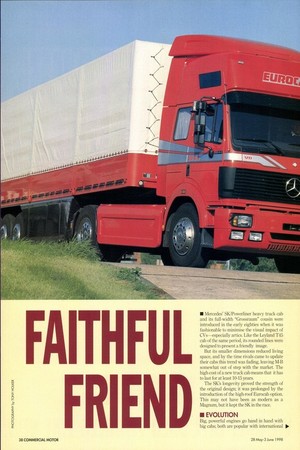
Page 43
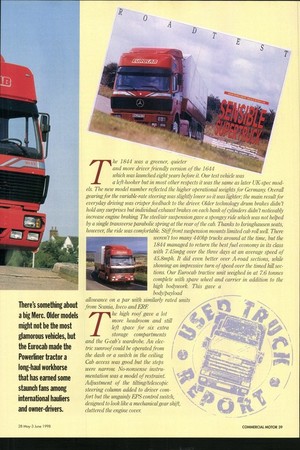
Page 44

Page 45
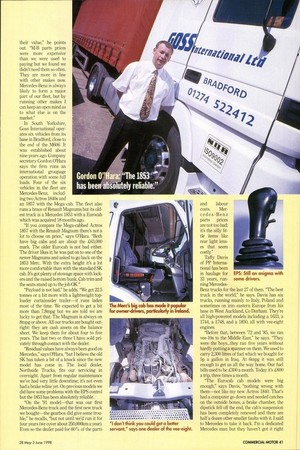
Page 46
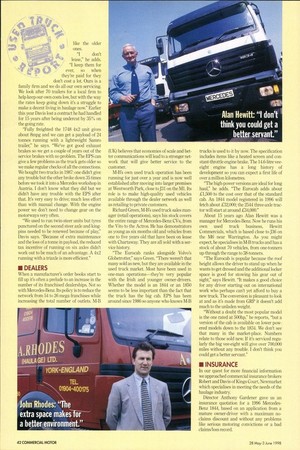
Page 47
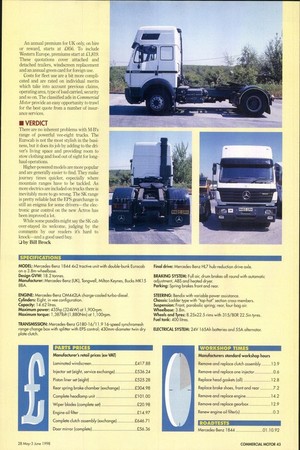
If you've noticed an error in this article please click here to report it so we can fix it.
might not be the most glamorous vehicles, but the Eurocab made the Powerliner tractor a long-haul workhorse that has earned some staunch fans among international hauliers and owner-drivers. The 1844 was a greener, quieter and more driver friendly version of the 1644 which was launched eight years before it. Our test vehicle was a left-hooker but in most other respects it was the same as later UK-spec models. The new model number reflected the higher operational weights for Germany Overall gearing for the variable-rate steering was slightly lower so it was lighter; the main result for everyday driving was crisper feedback to the driver Older technology drum brakes didn't hold any surprises but individual exhaust brakes on each bank of cylinders didn't noticeably increase engine braking The steel/air suspension gave a spongey ride which was not helped by a single transverse parabolic spring at the rear of the cab. Thanks to Isringhausen seats, however, the ride was comfortable. Sti ff front suspension mounts limited cab roll well There weren't too many 440hp trucks around at the time, but the 1844 managed to return the best fuel economy in its class with 745mpg over the three days at an average speed of 45.8mph. It did even better over A-road sections, while showing an impressive turn of speed over the timed hill sections. Our Eurocab tractive unit weighed in at 7.6 tonnes complete with spare wheel and carrier in addition to the high bodywork. This gave a body/payload allowance on a par with similarly rated units from Scania, Iveco and ERE The high roof gave a lot more headroom and still left space for six extra storage compartments and the G-cab's wardrobe. An electric sunroof could be operated from the dash or a switch in the ceiling Cab access was good but the steps were narrow No-nonsense instrumentation was a model of restraint. Adjustment of the tilting/telescopic steering column added to driver com fort but the ungainly EPS control switch, s. designed to look like a mechanical gear shift, cluttered the engine cover • Mercedes' SIVPowerliner heavy truck cab and its full-width "Grossraum" cousin were introduced in the early eighties when it was fashionable to minimise the visual impact of CVs—especially artics. Like the Leyland T45 cab of the same period, its rounded lines were designed to present a friendly image.
But its smaller dimensions reduced living space, and by the time rivals came to update their cabs this trend was fading, leaving MB somewhat out of step with the market. The high cost of a new truck cab means that it has to last for at least 10-15 years.
The SK's longevity proved the strength of the original design; it was prolonged by the introduction of the high-roof Eurocab option. This may not have been as modern as a Magnum, but it kept the SK in the race.
• EVOLUTION Big, powerful engines go hand in hand with big cabs; both are popular with international hauliers and MercedesBenz's 14.6-litre vee-eight could never be accused of being small or underpowered. How ever, it wasn't until 1992 with the 1844 that the company thought it necessary to give its L and full-width G-cabs extra head room with the Eurocab roof extension.
Even this was just a stop gap to stem the tide of operators looking towards Volvo's Globetrotter, Dots Spacecab and Renault's Magnum, while waiting for the new Actros cab to become available. The raised roofline added about 75kg to the unladen weight but gave more stowage space and standing room.
In the same year the company introduced its low-emission Euro-1 engine for the 1844, mated to its own lighter aluminium-cased G180 transmission in place of ZF's Ecosplit box, while retaining M-B's electronic power shifting (EPS) mechanism. The 14.6-litre naturally aspirated vee-eight power unit that produced just 276hp in 1980 was now rated at 435hp with 1,3871bft of torque in the 1844, aided by twin turbochargers and charge-cooling. In the 1850 tractive unit it punches out more than 500hp.
At the rear, M-B maintained its preference for a hub-reduction axle and air-bag suspension; up front variable power assistance was introduced into the steering. • OPERATORS The family business of A Rhodes Transport has been operating since 1979 and recently moved into new premises at Stockton-on-theForest on the outskirts of York. Today the company has 14 38-tonners and 10 rigids between 3.5-17 tonnes working on domestic and continental general haulage, although the company also specialises in the movement of portable accommodation units and abnormal loads The artic fleet is predominantly MercedesBenz but includes a couple of ERFs, two Volvos and, most recently, a Renault Premium. Some of the tractors are fitted with specialised equipment such as cranes, running on five and six axles to suit individual contracts The business is run by John Rhodes, whose father started out with Bedfords and Fords before trying out Volvos, Scanias and Mercs in the mid-eighties.
"In its class, the Mercedes-Benz was the best for all-round reliability and driver comfort at the time," says Rhodes "As well as having the least downtime, the 1625 gave us the best fuel consumption. We've always operated some Mercedes-Benz units since then. Our 2550 with a midlift steering axle is the only SK we have now with the Eurocab. The same driver has it for most of the time but other drivers say they like the space.
"I don't think it could be justified for domestic work for occasional nights out," he adds, "but this truck is away for up to three weeks at a time so there is some benefit for the driver. There are plenty of places to stow things and the extra space makes for a better environment. It's the only truck we have on contract hire, which gives the benefit of releasing cash for other development. Owning gives more flexibility in operation and we will always acquire some through outright purchase.
"'The hire agreement expires in November," says Rhodes. "I have the option to keep it for longer but if it's replaced, it will be like-forlike. The only unscheduled downtime we've had was due to the battery—just a couple of weeks after we took delivery it failed to start on a cold morning in Germany. We called out Mercedes-Benz breakdown and they had us on our way in a couple of hours. We've called for dealer backup for minor problems with other models and usually the fault has been put right at the side of the road. It's generally something electrical.
"The kindest thing I can say about the EPS gearbox control is that it is indifferent," Rhodes remarks. "The first set of tyres lasted 14 months; we changed them at 260,0001un. It's got drum brakes all round which have never been a problem, and the driver is happy with their performance. It runs with a tilt trailer and payload is sufficient for us—we don't usually carry more than about 21 tonnes. Earlier we ran an 1844 but we notice the difference in journey times with 500hp.
"Residual values are not our concern for the 2550 but there is always a demand for Mercedes-Benz trucks and so they do hold their value," he points out. "M-B parts prices were more expensive than we were used to paying but we found we didn't need them so often. They are more in line with other makes now. Mercedes-Benz is always likely to form a major part of our fleet, but by running other makes I can keep an open mind as to what else is on the market."
"If you compare the Mega-cabbed Actros 1857 with the Renault Magnum there's not a lot to choose on price," says O'Hara. "Both have big cabs and are about the £63,000 mark. The older Eurocab is not bad either. The driver likes it; he was put on to one of the newer Magnums and asked to go back on the 1853 Merc. With the extra height it's a lot more comfortable than with the standard SK cab. It's got plenty of stowage space with lockers and the raised bottom bunk. Cab trim and the seats stand up to the job OK."
"Payload is not bad," he adds. "We get 22.5 tonnes or a bit more with a lightweight toploader curtainsider trailer—it runs laden most of the time. We expected to get a bit more than 7.8mpg but we are told we are lucky to get that The Magnum is always on 8mpg or above. All our trucks are bought outright: they are cash assets on the balance sheet. We keep them for about four to five years. The last two or three I have sold privately through contact with the dealer.
"Residual values have always been good on Mercedes," says O'Hara, "but I believe the old SK has taken a bit of a knock since the new model has come in. The local dealer, Northside Trucks, fits our servicing in overnight. Apart from regular maintenance we've had very little downtime; it's not even had a brake reline yet On previous models we did have some problems with the EPS control but the 1853 has been absolutely reliable.
"On the '91 model—that was our first Mercedes-Benz truck and the first new truck we bought—the gearbox did give some trouble," he recalls, "but not until we'd run it for four years (we cover about 250,000km a year). Even so the dealer paid for 60% of the parts and labour costs. Mer cedes-Benz parts prices are not too bad; it's the silly little items like rear light lenses that seem costly" ning Mercedes Benz trucks for the last 27 of them. "The best truck in the world," he says. Davis has six trucks, running mainly to Italy, Poland and sometimes on into eastern Europe from his base in West Auckland, Co Durham. They're all high-powered models including a 1633, a 1744, a 1748, and a 1850, all with vee-eight engines.
"Before that, between '72 and '85, we ran vee-10s to the Middle East," he says. "They were the boys...they ran five years without hardly putting a spanner on them. We used to carry 2,300 litres of fuel which we bought for 5p a gallon in Iraq. At 6mpg it was still enough to get us all the way home. Our fuel bills used to be £300 a month. Today it's £600 a trip, three times a month.
"The Eurocab cab models were big enough," says Davis, "nothing wrong with them—not like my new Actros 1840. That's had a computer go down and needed catches on the outside boxes, a brake chamber, the dipstick fell off the end, the cab's suspension has been completely renewed and there are half a dozen other smaller faults with it. I said to Mercedes to take it back. I'm a dedicated Mercedes man but they haven't got it right like the older ones.
"I don't lease," he adds. "I keep them for ever, so when they're paid for they don't cost a lot. Ours is a family firm and we do all our own servicing. We look after 70 trailers for a local firm to help keep our own costs low, but with the way the rates keep going down it's a struggle to make a decent living in haulage now." Earlier this year Davis lost a contract he had handled for 15 years after being undercut by 35% on the going rate.
"Fully freighted the 1748 4x2 unit gives about 8mpg and we can get a payload of 24 tonnes running with a lightweight Samro trailer," he says. "We've got good exhaust brakes so we get a couple of years out of the service brakes with no problem. The EPS can give a few problems as the truck gets older so we make regular checks of all the connections. We bought two trucks in 1987: one didn't give any trouble but the other broke down 35 times before we took it into a Mercedes workshop in Austria. I don't know what they did but we didn't have any trouble with the EPS after that. It's very easy to drive; much less effort than with manual change. With the engine power we don't need to change gear on the motorways very often.
"We used to run twin-steer units but tyres punctured on the second steer axle and kingpins needed to be renewed because of play," Davis says. "Because of extra maintenance and the loss of a tonne in payload, the reduced tax incentive of running on six axles didn't work out to be much of an advantage. A 4x2 running with a triaxle is more efficient."
• DEALERS When a manufacturer's order books start to fill up it's often a prelude to an increase in the number of its franchised dealerships. Not so with Mercedes-Benz. Its policy is to reduce the network from 54 to 26 mega franchises while increasing the total number of outlets. M-B (UK) believes that economies of scale and better communications will lead to a stronger network that will give better service to the customer.
M-B's own used truck operation has been running for just over a year and is now well established after moving into larger premises at Wentworth Park, close to J31 on the MI. Its role is to make high-quality used vehicles available through the dealer network as well as retailing to private customers.
Richard Green, M-B's used truck sales manager (retail operations), says his stock covers the entire range of Mercedes-Benz CVs, from the Vito to the Actros. He has demonstrators as young as six months old and vehicles from one to five years old that have been on lease with Chartaway. They are all sold with a service history.
"The Eurocab ranks alongside Volvo's Globetrotter," says Green. "There weren't that many sold as new, but they are available in the used truck market Most have been used in one-man operations—they're very popular with the Irish and younger owner-drivers. Whether the model is an 1844 or an 1850 seems to be less important than the fact that the truck has the big cab. EPS has been around since 1986 so anyone who knows M-B trucks is used to it by now. The specification includes items like a heated screen and constant-throttle engine brake. The 14.6-litre veeeight engine has a long history of development so you can expect a first life of over a million kilometres.
"The high-power versions are ideal for long haul," he adds. "The Eurocab adds about £1,500 to the cost over that of the standard cab. An 1844 model registered in 1996 will fetch about £32,000; the 2544 three-axle tractor will start at around L34,000."
About 15 years ago Alan Hewitt was a manager for Mercedes-Benz. Now he runs his own used truck business, Hewitt Commercials, which is based close to J36 on the M6 near Warrington. As you might expect, he specialises in M-B trucks and has a stock of about 70 vehicles, from one-tonners up through the range to 38-tonners.
"The Eurocab is popular because the roof height allows the driver to stand up when he wants to get dressed and the additional locker space is good for stowing his gear out of sight," says Hewitt. "It makes a good choice for any driver starting out on international work who perhaps can't yet afford to buy a new truck. The conversion is pleasant to look at and as it's made from GRP it doesn't add much to the unladen weight "Without a doubt the most popular model is the one rated at 500hp," he reports, "but a version of the cab is available on lower powered models down to the 1834. We don't see that many in the market-place. Numbers relate to those sold new. If it's serviced regularly the big vee-eight will give over 700,000 miles without any trouble. I don't think you could get a better servant."
• INSURANCE In our quest for more financial information we approached commercial insurance brokers Robert and Davis of Kings Court, Newmarket which specialises in meeting the needs of the haulage industry.
Director Anthony Gardener gave us an insurance quotation for a 1996 MercedesBenz 1844, based on an application from a mature owner-driver with a maximum noclaims discount and without any problems like serious motoring convictions or a bad claims/loss record. An annual premium for UK only, on hire or reward, starts at £856. To include Western Europe, premiums start at £1,819. These quotations cover attached and detached trailers, windscreen replacement and an annual green card for foreign use.
Costs for fleet use are a bit more complicated and are rated on individual merits which take into account previous claims, operating area, type of load carried, security and so on. The classified ads in Commercial Motor provide an easy opportunity to trawl for the best quote from a number of insurance services.
• VERDICT There are no inherent problems with M-B's range of powerful vee-eight trucks. The Eurocab is not the most stylish in the business, but it does its job by adding to the driver's living space and providing room to stow clothing and food out of sight for longhaul operations.
Higher-powered models are more popular and are generally easier to find. They make journey times quicker, especially where mountain ranges have to be tackled. As more electrics are included on trucks there is inevitably more to go wrong. The SK range is pretty reliable but the EPS gearchange is still an enigma for some drivers—the electronic gear control on the new Actros has been improved a lot.
While some pundits might say the SK cab over-stayed its welcome, judging by the comments by our readers it's hard to knock—and a good used buy.
1:1 by Bill Brock






















































































































